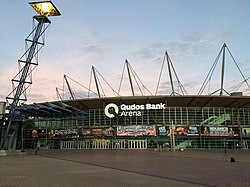
Back سيدني سوبر دوم Arabic Олфоунс Арена Bulgarian Qudos Bank Arena Czech Qudos Bank Arena German Qudos Bank Arena Spanish Acer Arena Basque Qudos Bank Arena French סידני סופרדום HE Arena Qudos Bank ID Qudos Bank Arena Italian
 Exterior view of venue from Olympic Bvd (c. 2016) | |
 | |
| Former names | Sydney SuperDome (1999–2006) Acer Arena (2006–2011) Allphones Arena (2011–2016) |
|---|---|
| Address | Olympic Bvd and Edwin Flack Avenue Sydney Olympic Park NSW 2127 Australia |
| Location | Sydney Olympic Park (Map) |
| Coordinates | 33°51′S 151°04′E / 33.850°S 151.067°E |
| Owner | TEG Live |
| Operator | ASM Global |
| Capacity | 18,000[2] 21,032 (with floor seats) |
| Construction | |
| Broke ground | September 1997 |
| Opened | 4 October 1999 |
| Construction cost | A$200 million ($381 million in 2022 dollars[1]) |
| Architect | Philip Cox and Yaeger Architecture |
| Structural engineer | Taylor Thomson Whitting |
| Services engineer | Norman Disney & Young |
| General contractor | Obayashi Corporation |
| Main contractors | Abigroup |
| Tenants | |
| Sydney Kings (NBL) (1999–2002, 2016–present) Sydney Swifts (CBT) (2001–08) New South Wales Swifts (ANZ/NNL) (2008–2019) Giants Netball (NNL) (2017–2019) | |
| Website | |
| Venue Website | |
The Sydney SuperDome (currently known as the Qudos Bank Arena for sponsorship reasons) is a multipurpose arena located in Sydney Olympic Park suburb of Sydney, New South Wales, Australia. It was completed in 1999 as part of the facilities for the 2000 Summer Olympics.
The A$190‑million facility was designed by COX Architecture & Devine deFlon Yaeger, and constructed by Abigroup and Obayashi Corporation.[3] Bob Carr, premier of New South Wales, officially opened the stadium in November 1999.[3]
The development of the stadium was part of three subsites which also included a 3,400-space carpark which cost A$25 million,[3] and a plaza with external works, also costing $25 million.[3] The roof's masts reach 42 metres (138 ft) above ground level, and the stadium occupies a site of 20,000 m2 (220,000 sq ft; 4.9 acres).[3]
The venue is currently managed by AEG Ogden. For three consecutive years it was a finalist for the Billboard Touring Awards in the top venue category.[4]
The arena has a total capacity of 21,032 with a seating capacity of around 18,000 making the SuperDome the largest permanent indoor sports and entertainment venue in Australia.
- ^ AU = 1850-1901: McLean, I.W. (1999), Consumer Prices and Expenditure Patterns in Australia 1850–1914. Australian Economic History Review, 39: 1-28 (taken W6 series from Table A1, which represents the average inflation in all of Australian colonies). For later years, calculated using the pre-decimal inflation calculator provided by the Reserve Bank of Australia for each year, input: £94 8s (94.40 Australian pounds in decimal values), start year: 1901.
- ^ "Qudos Bank Arena". Austadiums. Retrieved 8 June 2023.
- ^ a b c d e "Acer Arena - History". Archived from the original on 30 December 2012. Retrieved 4 April 2011..
- ^ "Allphones Arena, Rod Laver named in top three global live venues - Live Music - the Music Network". Archived from the original on 18 April 2012. Retrieved 11 April 2012.